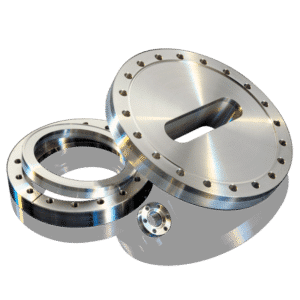Bimetallic Bonding for Ultrahigh Vacuum
Over the past 16 years Atlas Technologies has concentrated in developing methods and processes specifically intended for bonding dissimilar metals for use in Ultrahigh Vacuum (UHV). The details of this process are proprietary, but the following report provides a working understanding of the process. Atlas has received patents on several applications of this technology… including the metal-seal Atlas CF™ flange and Atlas ATCR™ fitting.
Metallurgical Bond
The Atlas CF™ flange is metallurgically bonded using an explosion welding process (EXW). Flange blanks are then cut from the bonded plate using a water-jet cutting process. Final machining of blanks assures UHV quality of the materials. Preparation for bonding requires that plates lay flat to each other. A flyer plate sits atop of a base plate and separated by a small gap. An explosive material, such as ammonium nitrate, is placed on top of the flyer plate and detonated from a point at one edge of the plate. The explosion is a controlled progressive ignition starting from one point on the surface of the flyer plate and progressing accross it, like the ripples on a pond created from the drop of a rock. The energy from the explosion accelerates the flyer plate against the base plate at impact velocities of 1800-2200 m/sec. A High energy surface plasma is formed between the plates, which moves ahead of the collision point striping electrons from the two bonding surfaces. The electron hungry metals are then thrust against each other at extreme pressures forming an electron sharing bond. Explosion welding (EXW) is a cold process that induces cold-work into the flyer plate, and a slight increase in magnetic properties when bonding to stainless steels. This effect can be mitigated if requested by the customer.
Bonding Parameters
Atlas has the capability of bonding many similar and/or dissimilar metals, but concentrates primarily on metals that are commonly needed for UHV applications. The formation of multi-laminates by explosive welding involves a working knowledge of the process variables and the ability to control them. These bonding parameters include explosive detonation velocity, explosive load and interface spacing. An understanding of the metallurgy of dissimilar metals at the bond interface is an additional factor to be considered. These three bonding parameters are quantifiable and with careful preparation of metals to be bonded make for a successful bonding event. The two constituent metals can be imagined to act as a viscous fluid in the reaction zone (bondline interface). Through the precise control of bonding parameters, interface turbulence is also controlled. An ultrahigh vacuum interface requires that a smooth flowing wave pattern be developed. Excessive turbulence results in leak paths and virtual leak possibilities.
Multi-layer Composites
Metals such as copper and stainless are readily bondable. However other metals such as aluminum and stainless are incompatible if bonded directly to each other. Many materials are not directly bondable without the formation of brittle intermetallic compounds. Atlas has developed patented multilayer composits technologies that provide metallurgical compatibility between aluminum and stainless, as well as other metals. Multi-layer composites also provide diffusion barriers eliminating the possibility of the formation of the brittle intermetallic compounds during weld up or through repeated heat cycles such as bakeout and high heat processes. Titanium and copper are the typical materials used for to achieve diffusion protection for aluminum/stainless flanges. All materials used are UHV compatible and are metallurgically bonded, no adhesives are used.
On close examination you will notice a wave pattern at the bond line. The pattern is developed in the bonding process as the flyer plate is accelerated against the base plate, like ripples in a pond. The wave pattern is more noticeable depending upon whether you are observing a crossing section or parallel section. The wave pattern increase the mechanical strength of the bond, in shear by offering mechanical interference, and tension by offering more bonded surface area. Base metals break before the bond fails. Explosion welding is a solid state process. The time duration of the explosion welding event is small and the heated reaction zone between the metals microscopic. The remaining thickness of the metal remains near ambient temperature and acts as a heat sink to the reaction zone. Therefore, the bondline is an abrupt transition between the metals with little, if any degradation of the metals. This process allows Atlas to produce stainless/aluminum and stainless/copper flanges while retaining a T-6 temper in the aluminum and, in the case of copper, maintaining a half hard RF78 condition. Other processes would anneal these materials leaving them too soft for many UHV applications
Bondline Wander
The explosion bonding process is violent leaving the bonded plate with obvious extrusions, deformations and warpages. Atlas takes great care to flatten the plate after bonding. As each flange is produced careful attention is given to positioning the bondline. This typically can be done ±0.04” and as small as ±0.012”. But, with careful examination, comparing one flange to another, you will observe that even though the flanges are dimensionally alike, no two flanges are the same when it comes to bondline location. Bondline wander does not affect the mechanical integrity nor the function of the flange for UHV application.
UHV Metal Bonding Capability
The explosive bonding process has been used as an industrial process for over 40 years. However, the industrial applications for large heat exchanges and for ship building are not suited for UHV where bonds must operate at leak rates less than 1×10-9 to 1×10-12 Torr. Atlas Technologies has developed UHV bonding processes for a group of metals commonly used in UHV applications. (See Bonding Matrix). Although the Atlas CF™ flange and Atlas ATCR™ fittings are most commonly used, Atlas also had developed successful bonding architectures for many metal combinations. Common Semiconductor and Particle Physics applications are:
Bonding Architectures:
Plate-to-plate bonding has been discussed above. Tube to tube coaxial bonding technology has also been developed.
References:
For further questions on the subject of explosive bonding there are now many excellent reviews, describing the process.
Cowman, G.R., O.O. Bagmen and A.H. Holtzman. Metal Transitions, 1971, vol 2, pp 3145-55
Shribman, V., A.S. Bahrani and B. Crossland, Production Engineering, Feb. 1969, pp 69-83
Blazinski, T.Z., Explosive Welding, Forming and Compaction, Applied Sciences Ltd., New York, London (1983), pp189-343

